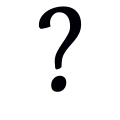¿ ?
 | ||||||||
| ||||||||
 | ||||||||
| ||||||||
See also: Appendix:Variations of "?"
Translingual
editPunctuation mark
edit- Encloses a question in some languages.
Usage notes
editThe symbols are called, in English:
- ¿ = rotated question mark (also 'turned', 'inverted')
- ? = question mark
See also
editCatalan
editPunctuation mark
edit- occasionally encloses a question in modern Catalan; at other times, a lone question mark is used at the end with nothing at the beginning of the question
Usage notes
edit- ⟨¿⟩ is used at the beginning of a question, with ⟨?⟩ at the end; however, it is not mandatory to use ⟨¿⟩.
See also
editSpanish
editPunctuation mark
edit- encloses a question in Spanish; equivalent in English and many other languages: ?
- ¿Cómo estás? ― How are you?
- Si tú fuiste, ¿a qué hora llegaste? ― If you went, at what time did you arrive?
Usage notes
edit- In written Spanish, the ⟨¿⟩ mark is placed at the beginning of an interrogative phrase, with the ⟨?⟩ at the end of the phrase. As SMS messaging and other forms of electronic communication have become more common, many speakers only use ⟨?⟩ for questions and ⟨!⟩ for exclamations, leaving out the initial typographical mark. This is considered non-standard usage.
Coordinate terms
editFurther reading
edit- Rotated question and exclamation marks on Wikipedia.Wikipedia
Tagalog
editEtymology
editPunctuation mark
edit¿ ? (archaic)
- encloses a question in Tagalog
Usage notes
edit- In writing, the ⟨¿⟩ mark is placed at the beginning of an interrogative phrase, with the ⟨?⟩ at the end of the phrase.
- This was common in Classical Tagalog, but fell out of use replaced by ⟨?⟩ outside of literature.
See also
editCategories:
- Character boxes with images
- Latin-1 Supplement block
- Basic Latin block
- Translingual lemmas
- Translingual punctuation marks
- Translingual matched pairs
- Translingual terms spelled with ¿
- Translingual terms spelled with ?
- Catalan lemmas
- Catalan punctuation marks
- Catalan matched pairs
- Catalan multiword terms
- Catalan terms spelled with ¿
- Catalan terms spelled with ?
- Spanish lemmas
- Spanish punctuation marks
- Spanish matched pairs
- Spanish multiword terms
- Spanish terms spelled with ¿
- Spanish terms spelled with ?
- Spanish terms with usage examples
- Tagalog terms borrowed from Spanish
- Tagalog terms derived from Spanish
- Tagalog lemmas
- Tagalog punctuation marks
- Tagalog multiword terms
- Tagalog terms spelled with ¿
- Tagalog terms spelled with ?
- Tagalog archaic terms